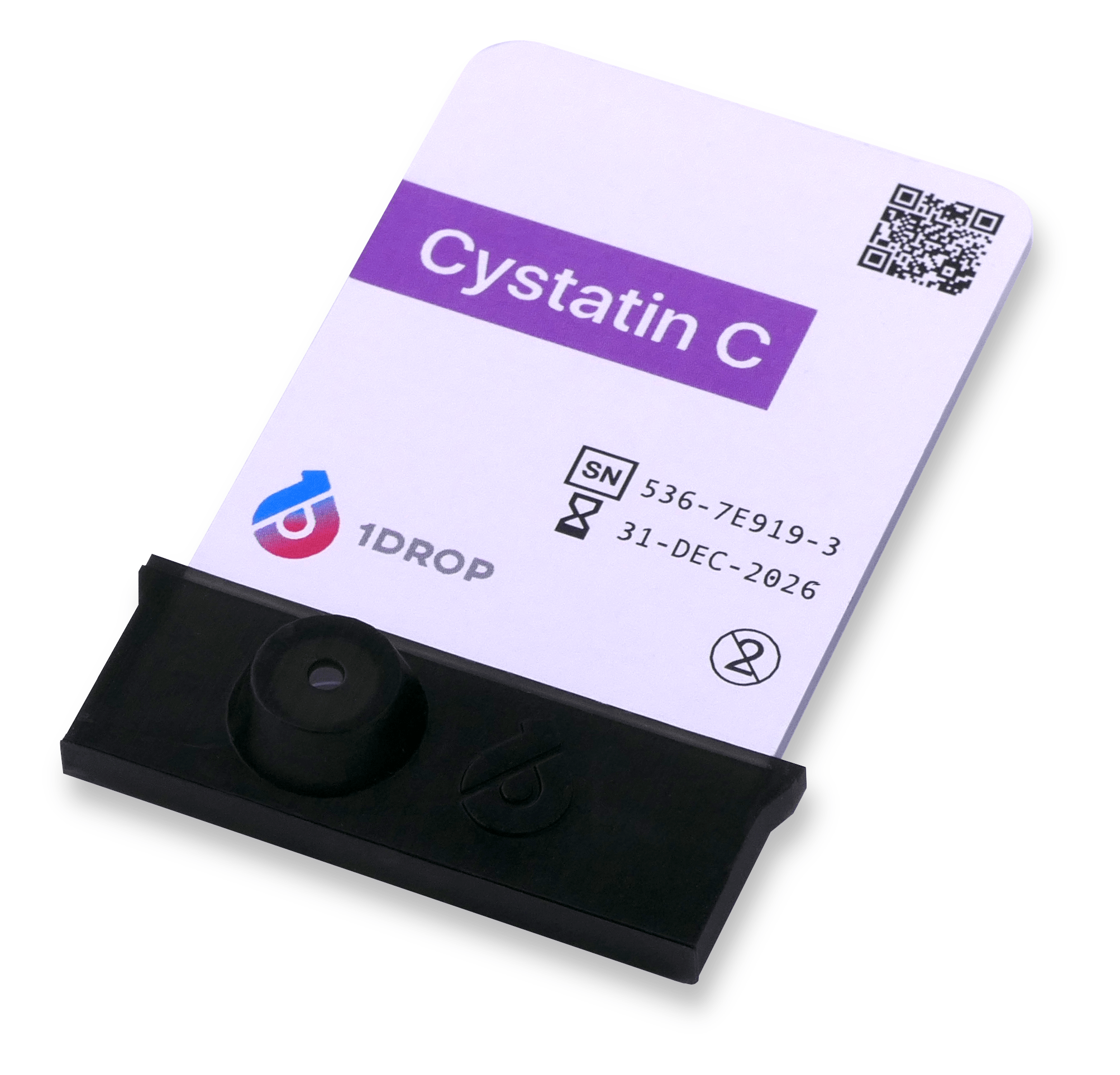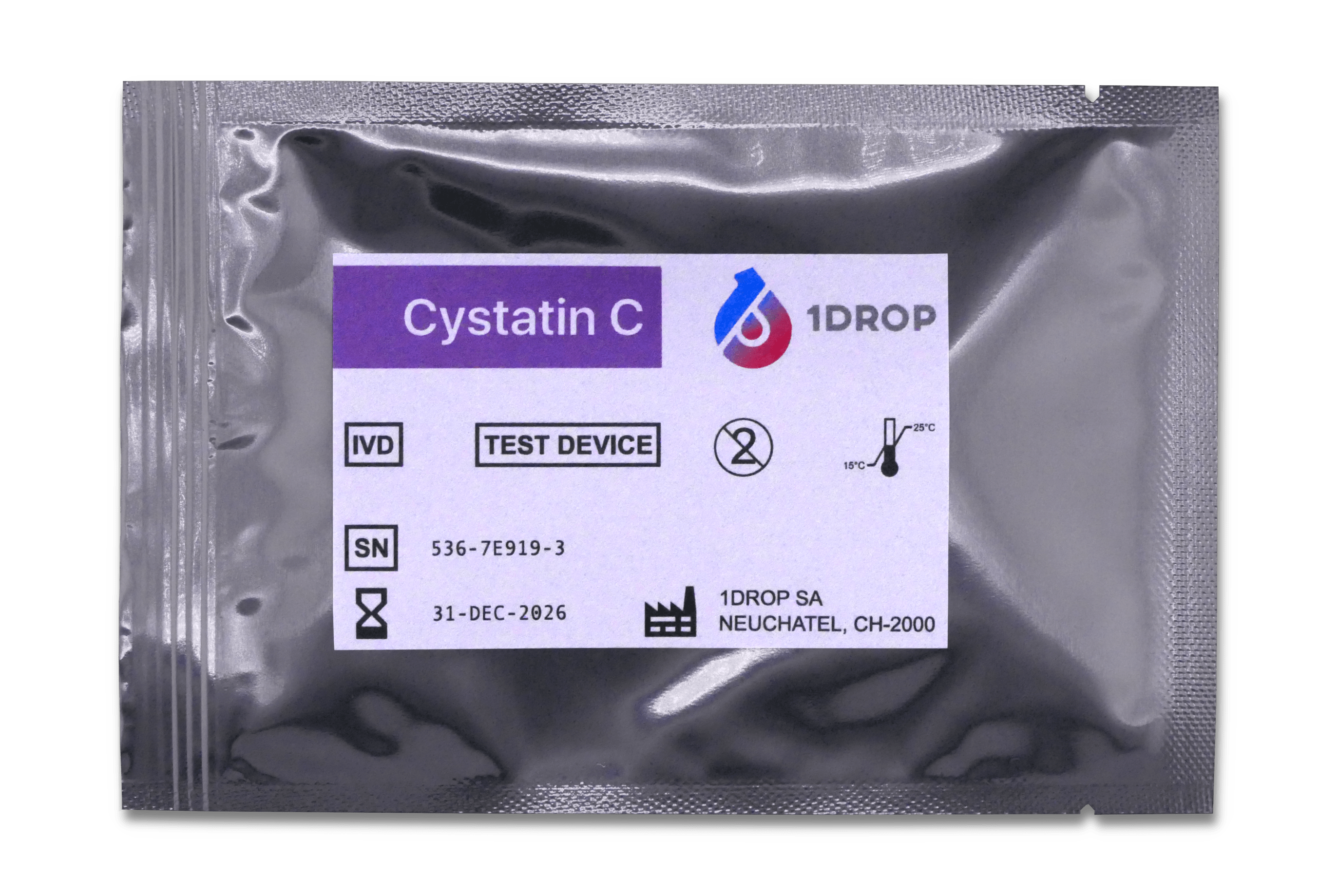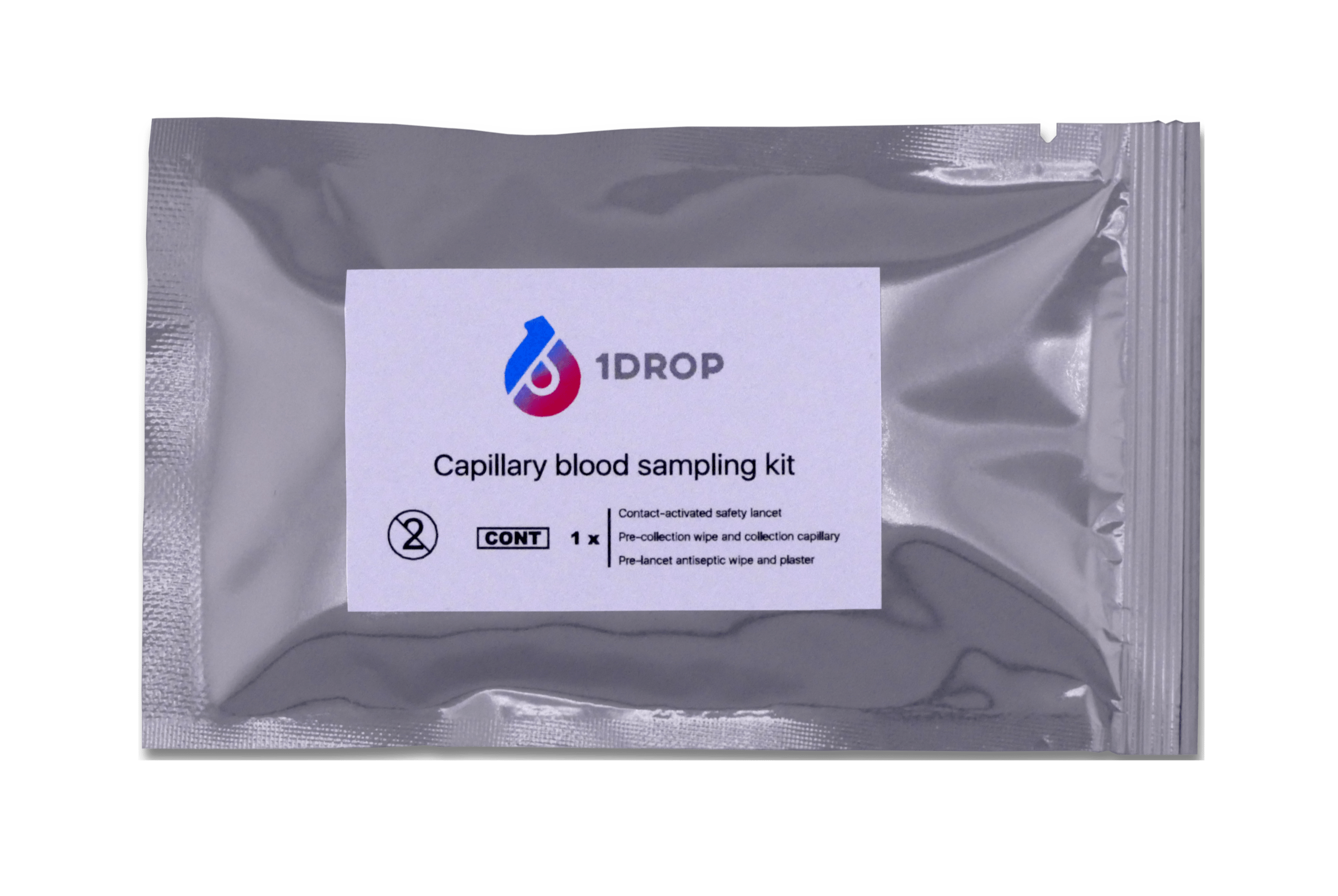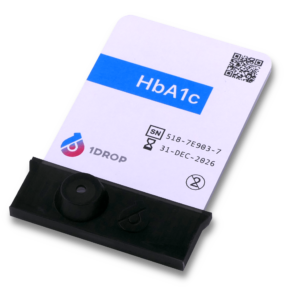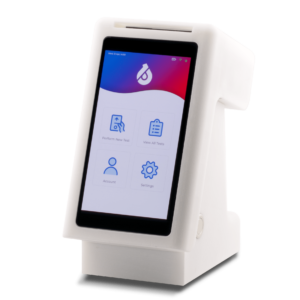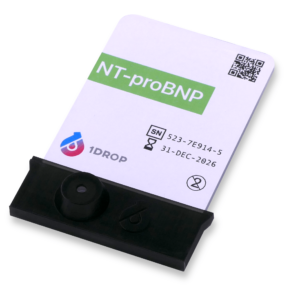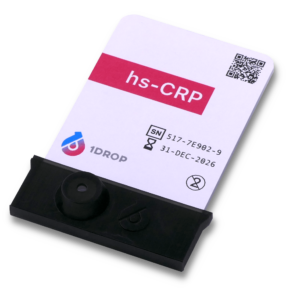Cystatin C
CHF 79.00
Know your risk of kidney disease by measuring the biomarker of kidney function cystatin C.
This is a pre-order product. We plan FDA 510(k) Clearance in North America and CE Mark in Europe in Q4 2024. We plan to start shipping in Q1 2025.
Capillary Blood Sample
Finger prick collection
Age 18+
10 minutes time to result
About the test
The Cystatin C Test measures the level of cystatin C in blood. Cystatin C is a protein that is produced by all nucleated cells in the body at a constant rate, is filtered by the kidneys, and excreted in urine. The level of cystatin C in blood is therefore an indirect measure of kidney function.
The Cystatin C Test is considered to be a more accurate indicator of kidney function than the commonly used creatinine test, especially in individuals with normal or mildly impaired kidney function. Cystatin C is less affected by factors such as muscle mass, age, sex, ethnicity, or diet, which can affect the accuracy of the creatinine test. The Cystatin C Test is particularly useful in assessing kidney function in the obese, elderly, or those with conditions that affect muscle mass.
Who should take this test
This test is suitable if you:
- Have heart disease
- Have high blood pressure
- Have diabetes
- Have kidney disease or a family history
- Have kidney stones or a family history
- Have a high protein diet
- Have used performance enhancing drugs
- Are taking anti-inflammatory medication
- Have a urinary tract disease
What’s tested
Cystatin C is a protein that is produced by all nucleated cells in the body, and is found in various body fluids, including blood. The kidneys filter and break down cystatin C from blood at a constant rate. The Cystatin C Test measures the amount of cystatin C in blood to assess kidney function.
The glomeruli in the kidneys filter cystatin C from blood, along with other substances, to form a filtrate fluid. The kidneys reabsorb cystatin C, glucose and other substances from this fluid, while the remaining fluid and waste are excreted as urine. The rate at which the fluid is filtered is called the glomerular filtration rate (GFR). A decline in kidney function leads to a decrease in the GFR and an increase in cystatin C levels.
Unlike creatinine, cystatin C is not significantly influenced by factors such as muscle mass, age, sex, ethnicity, or diet, making it a more reliable biomarker of kidney function. Cystatin C levels in blood remain stable when the kidneys are functioning normally, but increase as kidney function declines. This increase can be detected before there is a measurable decrease in kidney function and GFR. The Cystatin C Test can help in the early detection and monitoring of kidney disease.
Signs and Symptoms
More than 720 million people worldwide are estimated to have chronic kidney disease (CKD). Most people are undiagnosed and unaware they have the condition. During early-stage kidney disease you may not present any symptoms.
As time goes on, your kidneys may progressively lose their capacity to effectively remove waste and excess fluid from your blood. You may experience some of the following symptoms:
- Heart disease
- High blood pressure
- Diabetes
- Fatigue or weakness
- Swelling in the feet, ankles, or hands
- Shortness of breath
- Difficulty concentrating
- Loss of appetite or weight loss
- Increased frequency of urination
- Nausea or vomiting
- Headaches
- Itchy or dry skin
- Muscle cramps or twitches
Eligibility
The Cystatin C Test is available for anyone over the age of 18 who wishes to measure the functioning of their kidneys and their risk of developing kidney disease.
Before your Test
No special preparation is needed for this test. Fasting is not necessary.
After your Test
Your test results will be available in the 1DROP App and patient portal on the website, tablet or computer. You will receive a comprehensive and easy-to-understand report. You will be alerted if your results are outside the normal ranges.
Interpret the Results
The results of a Cystatin C Test are reported as a number in milligrams per liter (mg/L). The normal range for cystatin C is typically between 0.63 to 1.03 mg/L. If the results of a Cystatin C Test are higher than the normal range, it may indicate that there is some degree of kidney dysfunction or damage. It is important to discuss the results with a healthcare provider to make a definitive diagnosis and determine the most appropriate course of action including a treatment plan.
| Cystatin C Reference Range | |
| Age | Range (mg/L) |
| 0 to 1 year | Not established |
| 2 to 50 year | 0.63 to 1.03 |
| 51 to 60 years | 0.67 to 1.14 |
| 61 to 70 years | 0.72 to 1.16 |
| 71 to 80 years | 0.78 to 1.15 |
| >80 years | 0.87 to 1.12 |
HOW IT WORKS
Order online test anywhere

Choose Your Tests
Shop for tests on the 1DROP website or App. Order your tests and they will be shipped to you.

Test Your Sample
Insert the Chip into the Reader. Collect a finger prick of blood and place it on the Chip. The 1DROP Reader analyzes your sample within 15 minutes.

View Your Results
View your test results on the secure and private patient portal on your smartphone, tablet or computer. Easily share your results with your doctor, family, friends. Obtain guidance on your next steps.
BENEFITS
Take control of your health
Easy, rapid, affordable home testing
Convenient and Fast
Easy to Use and Understand
Personalized
Reduce Preanalytical Error
Private & Secure
Actionable Health Information
QUESTIONS
1. What's the difference between Cystatin C and Creatinine?
Cystatin C and Creatinine are both biomarkers of kidney function, but they differ in several key ways:
- Measurement: cystatin C is a small protein produced by all nucleated cells, while Creatinine is a waste product of muscle metabolism. Both are measured in the blood, but they have different molecular structures and are measured using different laboratory methods.
- Sensitivity: cystatin C is a more sensitive biomarker of kidney function than creatinine. It is not affected by factors such as age, sex, ethnicity, or muscle mass, which can affect Creatinine levels. As a result, cystatin C is often used in situations where Creatinine-based estimates of kidney function may not be accurate, such as in individuals who are obese or elderly.
- Timing: Creatinine levels in blood may not rise until there has been significant damage to the kidneys. In contrast, cystatin C levels increase much earlier in the course of kidney disease, which may help with earlier detection.
Cystatin C may be more sensitive and detect kidney disease earlier in situations such as in people with early-stage kidney disease, conditions that affect muscle mass, medication use, obesity or advanced age.
2. What does an elevated Cystatin C mean?
An elevated level of cystatin C in blood is indicative of impaired kidney function. The kidneys may not be functioning properly and may not be effectively filtering cystatin C out of the blood. Elevated levels of cystatin C are linked to various conditions that affect the kidneys, such as acute kidney injury, chronic kidney disease, and glomerulonephritis. This is a sign of kidney dysfunction and should be further evaluated by a healthcare professional to determine the underlying cause and appropriate treatment.
3. What are the risk factors for kidney disease?
There are several risk factors for kidney disease, including:
- Diabetes: high blood sugar levels can damage the blood vessels in the kidneys
- High blood pressure: high blood pressure can damage the blood vessels in the kidneys and reduce their ability to filter waste and excess fluids
- Family history of kidney disease
- Age: the risk of kidney disease increases with age
- Smoking
- Obesity: increases the risk of developing diabetes and high blood pressure, both of which can contribute to kidney disease
- Cardiovascular disease
- Chronic urinary tract infections: repeated infections can damage the kidneys
- Certain medications such as nonsteroidal anti-inflammatory drugs (NSAIDs), can damage the kidneys if taken over a long period of time or in high doses
Having one or more risk factors for kidney disease does not necessarily mean that you will develop the condition. It is important to be aware of these risk factors and take steps to manage them in order to reduce the risk of developing kidney disease.
4. How can I lower my Cystatin C?
Lowering your cystatin C levels can help improve your kidney health. Here are some ways you can potentially lower your cystatin C levels:
- Maintain a healthy weight
- Control your blood pressure
- Stay hydrated: drinking enough water can help keep your kidneys functioning properly
- Avoid smoking, limit alcohol consumption: quitting smoking and moderating your alcohol intake can help improve your kidney health
- Manage underlying health conditions: conditions such as diabetes and high cholesterol can contribute to kidney damage and elevated cystatin C levels. Work with your healthcare provider to manage these conditions and keep them under control
- Consider medication: some medications, such as angiotensin-converting enzyme (ACE) inhibitors and angiotensin receptor blockers (ARBs), can help protect your kidneys and lower cystatin C levels. You should only take these medications under the guidance of a healthcare professional
The effectiveness of these strategies in lowering your cystatin C levels may vary depending on your individual circumstances.
5. What is kidney disease?
Kidney disease, also known as renal disease, is a group of conditions that affect the functioning of the kidneys. The kidneys are a pair of bean-shaped organs that filter waste and excess fluids from the blood, regulate the body’s electrolyte balance, and produce hormones that help control blood pressure and red blood cell production.
The kidneys can become damaged and no longer perform these functions properly. This can lead to a buildup of waste and fluids in the body, electrolyte imbalances, and other complications.
There are different types of kidney disease, including:
- Chronic kidney disease: a progressive loss of kidney function over time, often caused by diabetes or high blood pressure
- Acute kidney injury: a sudden loss of kidney function, often caused by dehydration, blood loss, or side effects of medication
- Glomerulonephritis: inflammation of the kidneys’ filtering units, called glomeruli, often caused by autoimmune disorders or infections
- Polycystic kidney disease: a genetic condition in which cysts form in the kidneys and can eventually lead to kidney failure
Treatment for kidney disease typically involves managing underlying conditions, such as high blood pressure and diabetes, and may include medications and lifestyle changes. In severe cases, kidney transplant or dialysis may be necessary to replace the function of the damaged kidneys.

